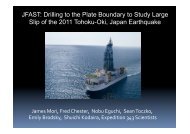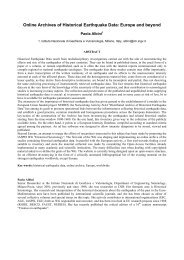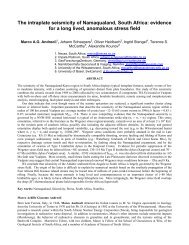A Preliminary Reconnaissance Report on August 11 2012 ...
A Preliminary Reconnaissance Report on August 11 2012 ...
A Preliminary Reconnaissance Report on August 11 2012 ...
You also want an ePaper? Increase the reach of your titles
YUMPU automatically turns print PDFs into web optimized ePapers that Google loves.
إFigure 15. A serviceable bridge after the earthquakes [Bastami, IIEES]Disaster Resp<strong>on</strong>seThe search and rescue operati<strong>on</strong> have d<strong>on</strong>e by survived people, NGOs and governmental organizati<strong>on</strong>s.Just four hours after the earthquake 87 killed and 400 injured people have found by search and rescueteams. The number of killed and injured people reported in 48 hours after the earthquake is indicated inFigure 16, which indicate the effectiveness of the search and rescue operati<strong>on</strong>. As shown in this figure,the lowest performance of the search/rescue teams happened between 7 to 13 hours after the earthquakewhich was midnight to early morning. Also as it can be seen in Figure 17, most of the killed peoplereported by hospitals were children and women.Due to the damages in the hospital, the treatment was d<strong>on</strong>e outside in the temporary hospitals setups inthe tents, as it can be seen in Figure 12. Rescue teams had to transmit the injured people to the hospitalsof the nearby cities.A remarkable traffic jam in Tabriz-Varzaghan, Tabriz-Ahar and other primary roads of the affected areawas <strong>on</strong>e of the most troubles of rescue teams. The main reas<strong>on</strong> for such traffic jams was large remarkablenumber of volunteers going to the affected areas for helping the rescue teams.The earthquake caused panic am<strong>on</strong>g about 2 milli<strong>on</strong> people in the Azerbaijan province; make manypeople sleep outside for several nights especially in Tabriz, see Figure 18. The earthquakes claimed morethan 30000 homeless who had to live in emergency shelters, as shown in Figure 19. Following theearthquakes, the presence of NGOs and self-motivated volunteers was remarkable and noticeable; as theyprovided essential needs of victims, see Figure 20. Despite all of the suffering, hope and life c<strong>on</strong>tinues inthe stricken area, as shown in Figure 21.Shortcomings of the crisis management: Disaster managers in this seismic event were not able to c<strong>on</strong>trolthe heavy traffic especially in the first days after the earthquakes. The traffic jam and panic behavior ofthe drivers caused several car accidents which claimed some victims. Different organizati<strong>on</strong>s, presentedinc<strong>on</strong>sistent statistics about the c<strong>on</strong>sequences of the event (e.g. number of killed and/or injured people).Such a situati<strong>on</strong> made the victims of the event worry and caused panic behavior. The emergency shelters(tents) were not suitable for the climate of the earthquake affected area. Although the earthquakehappened in summer, victims of the earthquake had to make fire outside their tents at nights because ofthe cold weather. Sanitary services in the emergency shelters were important needs of the victims. Lack ofpsychological counseling and mental therapies was <strong>on</strong>e of the most shortcomings of the crisismanagement in this earthquake.






